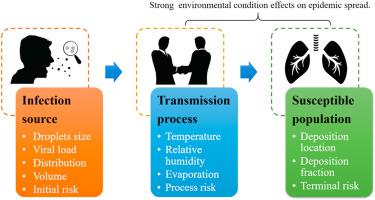当前位置:
X-MOL 学术
›
Build. Environ.
›
论文详情
Our official English website, www.x-mol.net, welcomes your feedback! (Note: you will need to create a separate account there.)
Transmission risk of infectious droplets in physical spreading process at different times: A review
Building and Environment ( IF 7.4 ) Pub Date : 2020-11-01 , DOI: 10.1016/j.buildenv.2020.107307 N Mao 1 , C K An 2 , L Y Guo 2 , M Wang 2 , L Guo 2 , S R Guo 2 , E S Long 1, 2
Building and Environment ( IF 7.4 ) Pub Date : 2020-11-01 , DOI: 10.1016/j.buildenv.2020.107307 N Mao 1 , C K An 2 , L Y Guo 2 , M Wang 2 , L Guo 2 , S R Guo 2 , E S Long 1, 2
Affiliation

|
Droplets provide a well-known transmission media in the COVID-19 epidemic, and the particle size is closely related to the classification of the transmission route. However, the term “aerosol” covers most particle sizes of suspended particulates because of information asymmetry in different disciplines, which may lead to misunderstandings in the selection of epidemic prevention and control strategies for the public. In this review, the time when these droplets are exhaled by a patient was taken as the initial time. Then, all available viral loads and numerical distribution of the exhaled droplets was analyzed, and the evaporation model of droplets in the air was combined with the deposition model of droplet nuclei in the respiratory tract. Lastly, the perspective that physical spread affects the transmission risk of different size droplets at different times was summarized for the first time. The results showed that although the distribution of exhaled droplets was dominated by small droplets, droplet volume was proportional to the third power of particle diameter, meaning that the viral load of a 100 μm droplet was approximately 106 times that of a 1 μm droplet at the initial time. Furthermore, the exhaled droplets are affected by heat and mass transfer of evaporation, water fraction, salt concentration, and acid-base balance (the water fraction > 98%), which lead them to change rapidly, and the viral survival condition also deteriorates dramatically. The time required for the initial diameter (do) of a droplet to shrink to the equilibrium diameter (de, about 30% of do) is approximately proportional to the second power of the particle diameter, taking only a few milliseconds for a 1 μm droplet but hundreds of milliseconds for a 10 μm droplet; in other words, the viruses carried by the large droplets can be preserved as much as possible. Finally, the infectious droplet nuclei maybe inhaled by the susceptible population through different and random contact routes, and the droplet nuclei with larger de decompose more easily into tiny particles on account of the accelerated collision in a complex airway, which can be deposited in the higher risk alveolar region. During disease transmission, the infectious droplet particle size varies widely, and the transmission risk varies significantly at different time nodes; therefore, the fuzzy term “aerosol” is not conducive to analyzing disease exposure risk. Recommendations for epidemic prevention and control strategies are: 1) Large droplets are the main conflict in disease transmission; thus, even if they are blocked by a homemade mask initially, it significantly contains the epidemic. 2) The early phase of contact, such as close-contact and short-range transmission, has the highest infection risk; therefore, social distancing can effectively keep the susceptible population from inhaling active viruses. 3) The risk of the fomite route depends on the time in contact with infectious viruses; thus, it is important to promote good health habits (including frequent hand washing, no-eye rubbing, coughing etiquette, normalization of surface cleaning), although blind and excessive disinfection measures are not advisable. 4) Compared with the large droplets, the small droplets have larger numbers but carry fewer viruses and are more prone to die through evaporation.
中文翻译:

不同时期物理传播过程中传染性飞沫的传播风险:综述
飞沫在 COVID-19 疫情中提供了众所周知的传播媒介,粒径大小与传播途径的分类密切相关。但由于不同学科信息不对称,“气溶胶”一词涵盖了悬浮颗粒物的大部分粒径,可能导致公众在疫情防控策略选择上存在误区。在本次审查中,这些飞沫被患者呼出的时间作为初始时间。然后,分析了所有可用的病毒载量和呼出飞沫的数值分布,并将飞沫在空气中的蒸发模型与飞沫核在呼吸道中的沉积模型相结合。最后,首次总结了物理传播影响不同时间不同大小飞沫传播风险的观点。结果表明,尽管呼出的飞沫分布以小飞沫为主,但飞沫体积与粒径的三次方成正比,这意味着 100 μm 飞沫的病毒载量约为 1 μm 飞沫的 106 倍。初始时间。此外,呼出的飞沫受到蒸发传热传质、水分含量、盐浓度和酸碱平衡(水分含量>98%)的影响,导致飞沫快速变化,病毒生存状况也急剧恶化. 液滴初始直径(do)收缩到平衡直径(de,大约30%的do)大约与粒径的二次方成正比,1μm的液滴只需要几毫秒,而10μm的液滴则需要数百毫秒;也就是说,大飞沫携带的病毒可以尽可能多地保存下来。最后,具有传染性的飞沫核可能通过不同的、随机的接触途径被易感人群吸入,较大的飞沫核在复杂的气道中加速碰撞,更容易分解成微小的颗粒,可以沉积在较高的风险肺泡区。疾病传播过程中,传染性飞沫粒径变化很大,不同时间节点传播风险差异显着;因此,模糊术语“气溶胶”不利于分析疾病暴露风险。疫情防控策略建议:1)大飞沫是疾病传播的主要冲突;因此,即使他们最初被自制口罩挡住,它也能显着遏制疫情。2)早期接触阶段,如近距离接触、近距离传播,感染风险最高;因此,保持社交距离可以有效防止易感人群吸入活性病毒。3)污染途径的风险取决于接触传染性病毒的时间;因此,重要的是要养成良好的卫生习惯(包括勤洗手、不揉眼、咳嗽礼仪、表面清洁常态化),但盲目和过度的消毒措施是不可取的。4)与大液滴相比,
更新日期:2020-11-01
中文翻译:

不同时期物理传播过程中传染性飞沫的传播风险:综述
飞沫在 COVID-19 疫情中提供了众所周知的传播媒介,粒径大小与传播途径的分类密切相关。但由于不同学科信息不对称,“气溶胶”一词涵盖了悬浮颗粒物的大部分粒径,可能导致公众在疫情防控策略选择上存在误区。在本次审查中,这些飞沫被患者呼出的时间作为初始时间。然后,分析了所有可用的病毒载量和呼出飞沫的数值分布,并将飞沫在空气中的蒸发模型与飞沫核在呼吸道中的沉积模型相结合。最后,首次总结了物理传播影响不同时间不同大小飞沫传播风险的观点。结果表明,尽管呼出的飞沫分布以小飞沫为主,但飞沫体积与粒径的三次方成正比,这意味着 100 μm 飞沫的病毒载量约为 1 μm 飞沫的 106 倍。初始时间。此外,呼出的飞沫受到蒸发传热传质、水分含量、盐浓度和酸碱平衡(水分含量>98%)的影响,导致飞沫快速变化,病毒生存状况也急剧恶化. 液滴初始直径(do)收缩到平衡直径(de,大约30%的do)大约与粒径的二次方成正比,1μm的液滴只需要几毫秒,而10μm的液滴则需要数百毫秒;也就是说,大飞沫携带的病毒可以尽可能多地保存下来。最后,具有传染性的飞沫核可能通过不同的、随机的接触途径被易感人群吸入,较大的飞沫核在复杂的气道中加速碰撞,更容易分解成微小的颗粒,可以沉积在较高的风险肺泡区。疾病传播过程中,传染性飞沫粒径变化很大,不同时间节点传播风险差异显着;因此,模糊术语“气溶胶”不利于分析疾病暴露风险。疫情防控策略建议:1)大飞沫是疾病传播的主要冲突;因此,即使他们最初被自制口罩挡住,它也能显着遏制疫情。2)早期接触阶段,如近距离接触、近距离传播,感染风险最高;因此,保持社交距离可以有效防止易感人群吸入活性病毒。3)污染途径的风险取决于接触传染性病毒的时间;因此,重要的是要养成良好的卫生习惯(包括勤洗手、不揉眼、咳嗽礼仪、表面清洁常态化),但盲目和过度的消毒措施是不可取的。4)与大液滴相比,



























 京公网安备 11010802027423号
京公网安备 11010802027423号